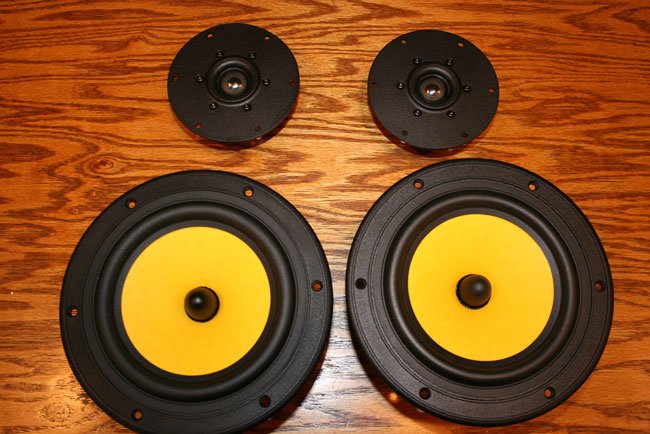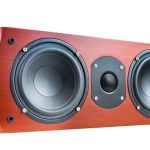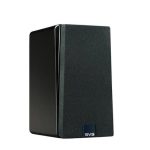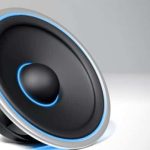Tweeters are small audio drivers that are specially designed to reproduce upper sound frequencies, which are generally known as high-frequency sounds or treble. Treble includes drum effects and high-pitched sounds from musical instruments. Tweeters are small in size since they reproduce smaller sound waves than regular speaker drivers. Most tweeters are limited to a frequency range of between 3 kHz to 20 kHz.
There’re several types of tweeters designed today. Although they’re all meant to reproduce high frequencies, they differ in shape, materials, some components, and functions or area of application. Let’s look at different types of tweeters and their functions.
Dome Tweeters
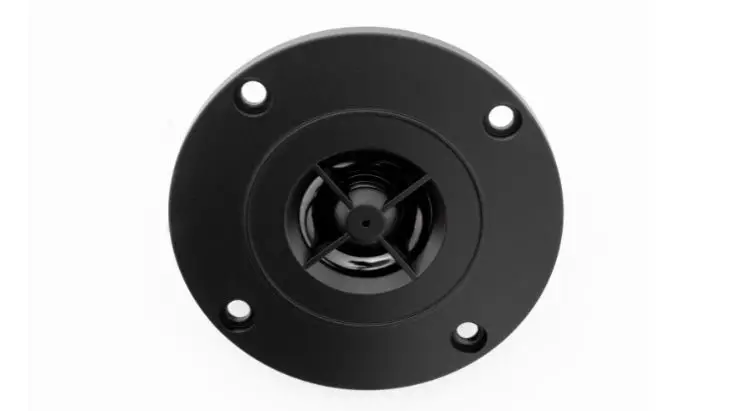
Dome tweeters are some of the most common types of tweeters. The design behind dome tweeters is a dome that has a suspension and an aluminum wire coiled around the rim of the dome. The moving component of the tweeter is mounted on a plastic framing and positioned within a ring magnet. Additionally, a faceplate is usually installed on the top area of the dome tweeter to control the overall direction of the sound.
Dome tweeters come in different driver materials. The most common materials used in dome tweeter drivers are titanium, plastic, aluminum, beryllium, doped fabric, treated cloth, silk, and composite materials. These materials bring about two classifications of dome tweeters, which are soft-dome tweeters and metal dome tweeters.
Soft-dome tweeters are dome tweeters made of fabric or silk material. They’re highly dampened and don’t ring like metal. Their frequency response is generally smoother than metal. Soft-dome tweeters have lower resonance frequency, more headroom for extreme sound pressure, and higher power handling. However, soft-dome tweeters are extremely delicate and less stiff.
On the other hand, metal dome tweeters are dome tweeters made of a metallic material such as titanium, beryllium, or aluminum. They can also be made of alloys of these metals. Their main advantage is that they break up better than soft dome tweeters. They’re also stiffer than soft dome tweeters. However, metal dome tweeters tend to ring.
Regardless of the material used in a dome tweeter, what matters most is the overall quality of the high frequencies produced by the tweeter. Since there’s no single perfect material for a dome tweeter, it’s all about balancing all the essential factors without compromising on any important aspect during the design process. Dome tweeters are mainly used in home audio equipment.
Semi-Dome Tweeters
Semi-dome tweeters are cone-shaped and have an inbuilt dome. This tweeter design allows for a smaller tweeter profile. Thus, semi-dome tweeters are mostly used in coaxial speakers. Their small size makes it possible to include them in coaxial speakers without increasing the overall size of the speaker significantly. They’re also inexpensive to manufacture, making them a great choice for use in lower-end speakers.
Cone Tweeters
Cone tweeters resemble regular subwoofers in shape. They’re round, small, and lightweight. They’re typically made of a paper cone. Thus, they’re popularly known as paper cone tweeters. These tweeters deliver crisp highs. They’re inexpensive to design and manufacture. However, cone tweeters are prone to moisture damage. They’re also prone to popping and ripping when pushed extremely hard. These tweeters are mostly found in older speakers. They’re less popular in modern sound systems.
Piezo Tweeters
Piezo tweeters are a type of tweeters made of piezoelectric crystal material and a mechanical diaphragm. Current flows through the piezo material. The crystal responds according to the frequency and amplitude of the current flowing through it. These tweeters are highly efficient. They’re also easier to drive. Thus, they deliver loud highs with minimal power input. This makes them ideal for use in less powerful speaker systems and portable radios.
Ribbon Tweeters
Ribbon tweeters are a type of tweeter that uses a thin, flat diaphragm. The diaphragm is generally made of aluminum foil or metalized polymer film. These twitters are extremely light and highly responsive. Thus, they’re ideal for applications that demand detailed resolution. They offer broader and more horizontal dispersion, thereby allowing for a wider sweet spot. However, ribbon tweeters are expensive. Also, they’re less effective in reproducing lower limit highs.
Electrostatic Tweeters
Electrostatic speakers use an electrically-charged diaphragm to reproduce highs. They have a polyester film diaphragm which is coated with a conductive layer. The diaphragm vibrates between two stators that are powered by electrostatic force. Their main benefit is that the diaphragm doesn’t produce heat as it uses voltage rather than current. They don’t distort easily and are light. However, they have to be large for reasonable sensitivity and are affected by humidity and dust.
Super Tweeters
A super tweeter is a special type of tweeter that is designed to extend the high-frequency response of normal tweeters in a coaxial speaker. They reproduce the highest frequencies that regular tweeters cannot. They enhance the density and detail of an existing sound system. They’re ideal for reproducing highs from high-fidelity systems such as ultrahigh definition Bluray.
Ring Radiator/Concentric Tweeters
Ring radiator tweeters, also known as concentric tweeters, have a center plug surrounded by some rings. They produce accurate and detailed highs. Moreover, they disperse high frequencies widely. However, they’re less common.
Air Motion Transformer Tweeters
Air motion transformers (ATM) tweeters are a less common type of tweeters. They’re made of aluminum conductors and a thin, folded film diaphragm. The diaphragm is positioned between opposing magnets. As current passes through, the diaphragm folds. It contracts and expands as it folds, thereby forcing air in and out. As a result, high-frequency sounds are produced. However, ATM tweeters are expensive and challenging to manufacture.
Plasma/Ion Tweeters
The operating principle behind these tweeters is the use of electrically charged ionized gas. Plasma/ion tweeters are extremely complex than other types of tweeters. Their moving mass is exceptionally low, thereby making them highly responsive with minimal current input. However, they’re less safe for use because they produce small amounts of ozone, which is a poisonous gas.
Horn Tweeters
Horn tweeters are any of the aforementioned tweeters mounted in a horn structure. Thus, the design behind a horn tweeter can be a dome driver, piezo driver, cone driver, or any other tweeter driver mounted in a horn. The horn structure enhances the efficiency of the direction of high-frequency sounds. Horn tweeters are challenging to design but are very efficient. These tweeters are ideal for use in outdoor speaker systems due to their loudness and wide sound dispersion.
Conclusion
Tweeters come in different shapes, sizes, materials, and operating principles. Although they’re all designed to reproduce highs, some are more reliable in certain applications than others. Now that you know the different types of tweeters, you’ll be able to figure out the ideal type for a specific application.
You may also like to read: Guide on Installing Car Tweeters Yourself.
Michael Evanchuk is a San Francisco-based sound engineer with 20 years’ experience installing, troubleshooting, and repairing commercial, automotive, and household sound equipment. Evanchuk owns an auto stereo center, where he offers highly competitive car audio installation and repair services. He has written dozens of articles on different sound engineering topics, all of which have been published in leading journals, blogs, and websites.

